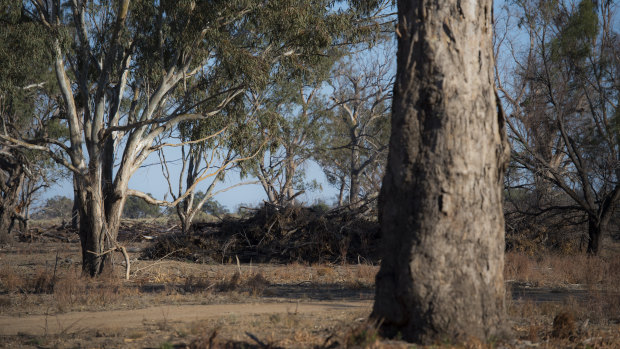This was published 3 years ago
Analysis finds $300m paid to farmers to keep trees they were unlikely to clear
By Mike Foley
Landholders in far western NSW received a combined $300 million in public funds under a carbon credit scheme to not remove trees from their land, but experts say farmers were unlikely to have chopped them down even if they weren’t paid.
Projects registered under the Commonwealth Emissions Reductions Fund (ERF) avoided deforestation scheme were required to provide additional carbon capture that would not have occurred without payments to farmers for forfeiting land clearing rights.

New analysis shows the Commonwealth spent millions on carbon credits to stop land clearing of trees which were unlikely to be cut down. Credit: Wolter Peeters.
Between 2013 and 2016 the federal government signed 63 deals under the ERF to capture a total of 22 million tonnes of carbon that would not otherwise have been sequestered because the trees would have been removed.
However, analysis by the Australia Institute, published on Wednesday, shows trees on land covered by ERF deals were unlikely to have been removed, even though to apply to the ERF landholders needed valid land clearing permits issued by the NSW government.
Commenting on the analysis, Australian National University associate professor of environmental economics Dr Paul Burke said the government had bought a large amount of carbon capture that would have happened anyway, without any payments.
“It’s very unrealistic that they all would have gone out and done that clearing over the time period,” Dr Burke said.
The typical rate of land clearing in far western NSW would have needed to spike by between 751 per cent and 12,804 per cent for all those trees to have been chopped down, based on the historical land clearing rates between 1988 and 2013.
“There would have to have been a large-scale boom in clearing for [landholders] to have used all of their land clearing rights,” Dr Burke said.
The federal government is developing new criteria for payments to landholders who invest in soil carbon sequestration and Dr Burke said it was imperative lessons are learned from avoided deforestation to avoid wasting taxpayers’ money.
The Clean Energy Regulator, which oversees the ERF, said the Australia Institute and Australian Conservation Foundation analysis was based on “highly questionable assumptions” and it is “not aware of robust evidence” that discredits the avoided deforestation scheme.
Carbon credits issued to landholders under the ERF are valid for 15 years, known as the crediting period. The scheme issues credits for a range of carbon abatement projects including in landfill, mining, and livestock production and has committed $4.5 billion since 2013.
The Carbon Market Institute, which brokers deals between government and landholders, said the analysis ignored the fact that even though the ERF crediting period ran for 15 years, landholders sign covenants preventing trees from being cleared for 100 years.
“There is a suggestion that these properties weren’t going to be cleared. Unfortunately, every year more land is cleared and it’s a mug’s game to say what will happen over the next 100 years,” Carbon Market Institute chief executive John Connor said.
“I can’t speak for each property, but after visiting project areas in NSW I have witnessed farmers who have protected parts of their land under this method and cleared areas where the method couldn’t be applied,” Mr Connor said.
The Australia Institute climate and energy director Richie Merzian said it was the crediting period rather than the covenant that was relevant to ERF payments.
“This entire method is based on permit holders having 15 years to clear their land, and you have to assume that is the baseline. That makes for an impossible situation, where you’re looking at a clearing rate of at least 750 per cent higher than it actually was. You would question if there are enough bulldozers in NSW do that job,” Mr Merzian said.
Carbon savings under the ERF are not counted towards Australia’s national emissions budget.
The Morning Edition newsletter is our guide to the day’s most important and interesting stories, analysis and insights. Sign up here.